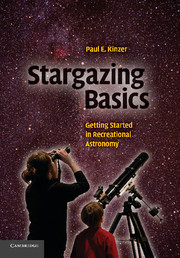Book contents
Summary
Targets for the amateur astronomer that are outside the Solar System are both easier and more difficult to find. Easier, because they stay in pretty much the same spot on the celestial sphere for centuries or longer, so planispheres, field guides and star charts that show their positions can be used at any time of year, and for many years. More difficult, because they are dimmer, usually much dimmer, than the planets, though they often cover a much larger area of the sky. This makes many deep-sky objects prime targets for binoculars rather than telescopes, since the higher magnification of telescopes makes it impossible to fit many of these objects entirely within view at one time.
There are several types of deep-sky objects that can be viewed by the amateur: stars, star clusters, galaxies, and nebulae (or nebulas); and all of these categories contain their own types. Each is described below. There are other types of objects out there, like quasars and black holes, but they are not visible in beginners' scopes (or at all!), so they will be left alone.
Stars
Stars are immense balls of compressed gas, so squeezed by their own gravity that nuclear reactions take place within them, and they begin to shine. They can be smaller than the Earth in diameter, or larger than the diameter of the orbit of Mars. They can be red, orange, yellow, white, or blue; and to the human eye at the telescope, other colors are also seen.
- Type
- Chapter
- Information
- Stargazing BasicsGetting Started in Recreational Astronomy, pp. 96 - 106Publisher: Cambridge University PressPrint publication year: 2008



